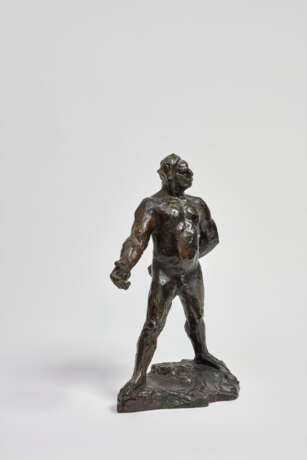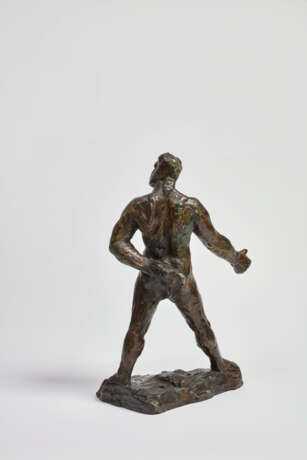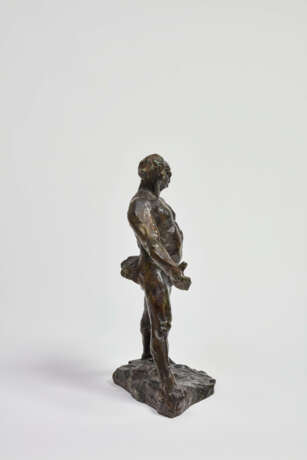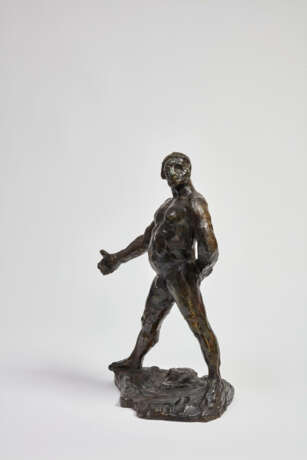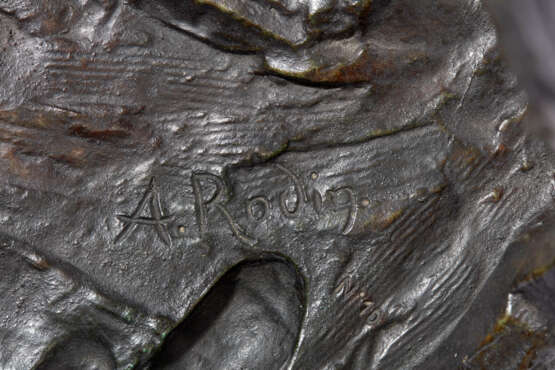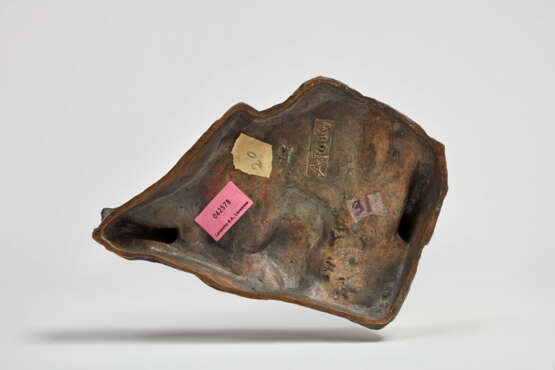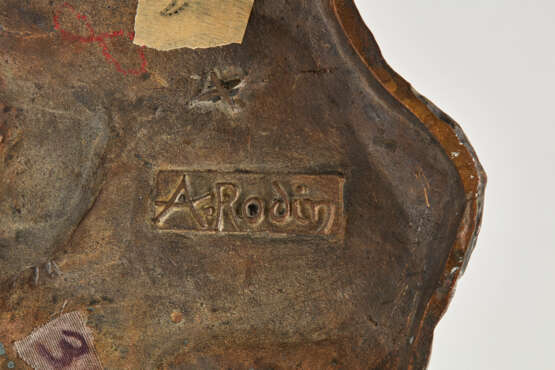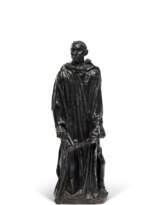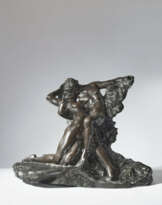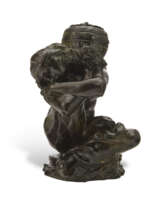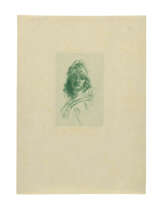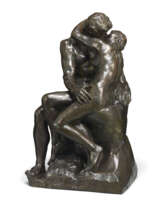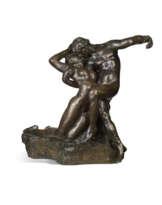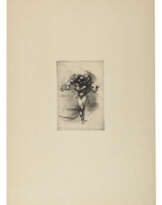ID 1051731
Lot 446 | Auguste Rodin (1840-1917)
Estimate value
€ 140 000 – 180 000
Balzac, Étude de nu au gros ventre, bras droit tendu, bras gauche plié dans le dos dit aussi Balzac, étude type A
signé et numéroté ‘A. Rodin. N.10’ (sur la terrasse); avec la marque du fondeur ‘Georges Rudier. Fondeur. Paris.’ (à l’arrière de la base); daté et inscrit '© by musée. Rodin. 1962' (sur le côté droit de la base); avec le cachet de la signature en relief 'A. Rodin' (à l'intérieur)
bronze à patine brun foncé
Hauteur: 40.7 cm.
Conçu vers 1894; cette épreuve fondue en 1962 dans une édition de 12 exemplaires
signed and numbered 'A. Rodin N.10' (on the top of the base); with the foundry mark 'Georges Rudier. Fondeur. Paris.' (at the back of the base); dated and inscribed '© by musée. Rodin. 1962' (on the right side of the base); with the raised signature 'A. Rodin' (inside)
bronze with dark brown patina
Height: 16 in.
Conceived circa 1894; this bronze cast in 1962 in an edition of 12
Provenance
Musée Rodin, Paris.
Sam Josefowitz, Pully (acquis auprès de celui-ci en juillet 1962).
Puis par descendance aux propriétaires actuels.
Literature
J. L. Tancock, The Sculpture of Auguste Rodin, The Collection of the Rodin Museum Philadelphia, Philadelphie, 1976, p. 458.
A. E. Elsen, Rodin's Art, The Rodin collection of the Iris & Gerald Cantor Center for Visual Arts at Stanford University, New York, 2003, p. 401, no. 108 (une autre épreuve illustrée).
A. Le Normand-Romain, Rodin et le bronze, Catalogue des œuvres conservées au Musée Rodin, Paris, 2007, vol. I, p. 174, no. S. 585 (une autre épreuve illustrée).
Exhibited
(prêt) Toronto, Art Gallery of Ontario (depuis 2009).
Further details
En juillet 1891, Rodin accepte la commande de la Société des Gens de Lettres pour commémorer Balzac. Le sculpteur déclare à la presse que son sujet est "un créateur qui fait vivre tout ce qu'il voit... et qui sait le peindre avec des traits d'une réalité frappante. Je considère La Comédie Humaine comme le plus grand morceau d'humanité véritable jamais couché sur le papier... Balzac est avant tout un créateur et c'est cette idée que je voudrais faire comprendre dans ma statue" (cité dans A. E. Elsen, Rodin's Art, The Rodin collection of the Iris & Gerald Cantor Center for Visual Arts at Stanford University, New York, 2003, p. 353). Rodin s'engage à livrer la sculpture achevée, qui sera érigée sur la place du Palais Royal, dans un délai de dix-huit mois ; ses honoraires s'élèvent à dix mille francs, montant laissé dans les caisses de la Société par la précédente tentative de célébration de Balzac, par le sculpteur Henri Chapu, décédé avant de l'avoir achevée. Rodin se plonge rapidement dans ce projet, dont il dévoile la version finale, controversée, au Salon de Paris de 1898. En visitant l’exposition, Félix Faure, président français, aurait tourné le dos à l'œuvre et se serait éloigné sans rien dire. Bien que Rodin ait d'ardents défenseurs parmi les commentateurs les plus perspicaces, le ridicule est tel que le comité de la Société annonce qu'il ne reconnaîtra pas l'œuvre. Rodin se voit refuser ses honoraires et doit accepter comme une perte irrécupérable les dépenses considérables qu'il a engagées dans le cadre de cette commande. Deux semaines après l'ouverture du Salon, Rodin retire la sculpture et l'emporte dans sa maison de Meudon, où seuls lui et ses amis peuvent la contempler.
Rodin avait l'habitude de modeler des figures nues – comme dans le présent motif – afin de saisir la musculature et l'architecture générale du corps avant de l'habiller. "Aucune tentative n'a été faite pour dissimuler l'impressionnante corpulence de la figure... en fait, la forme qui résulte de l'indulgence gastronomique et de l'indolence physique de Balzac est affichée... C'est l'une des conceptions les plus inspirées, les plus audacieuses et les plus passionnées de Rodin pour son Balzac" (ibid., p. 401).
In July 1891, Rodin accepted the Société des Gens de Lettres's commission to commemorate Balzac. The sculptor told reporters his subject was "a creator who brings to life all that he sees... and knows how to paint it with traits of striking reality. I consider La Comédie Humaine as the greatest piece of true humanity ever thrown down on paper... Balzac is before everything a creator and this is the idea that I would wish to convey in my statue" (quoted in A. E. Elsen, Rodin's Art, The Rodin collection of the Iris & Gerald Cantor Center for Visual Arts at Stanford University, New York, 2003, p. 353). Rodin agreed to deliver the completed sculpture, which was to be erected in the square of the Palais Royal, within eighteen months. His fee was ten thousand francs, the amount left in the Société's fund from the previous attempt to celebrate Balzac, by sculptor Henri Chapu, who died before completing it. Rodin soon immersed himself in this project, the final version of which he unveiled, to controversy, in the Paris Salon of 1898. Touring the galleries, Félix Faure, the French President, reportedly turned his back on the work and walked away, saying nothing. While Rodin had ardent defenders among the most perceptive commentators, the ridicule was such that the Société committee announced they would not recognize the work. Rodin was refused his fee, and had to accept as an unrecoverable loss the considerable expenses he had incurred while working on the commission. Two weeks after the opening of the Salon, Rodin withdrew the sculpture and took it to his home in Meudon, where only he and his friends could contemplate it.
It was Rodin's practice to model the figure of clothed subjects in the nude – as in the present motif – in order to grasp the body's muscularity and overall architecture before dressing it. "No attempt was made to disguise the figure's impressive girth... in fact, the shape that resulted from Balzac's gastronomic indulgence and physical indolence is flaunted... This is one of Rodin's most inspired, daring and passionate conceptions for his Balzac" (ibid., p. 401).
| Artist: | François Auguste René Rodin (1840 - 1917) |
|---|---|
| Applied technique: | Metalwork |
| Medium: | Bronze |
| Artist: | François Auguste René Rodin (1840 - 1917) |
|---|---|
| Applied technique: | Metalwork |
| Medium: | Bronze |
| Address of auction |
CHRISTIE'S 9 Avenue Matignon 75008 Paris France | ||||||||||||||
|---|---|---|---|---|---|---|---|---|---|---|---|---|---|---|---|
| Preview |
| ||||||||||||||
| Phone | +33 (0)1 40 76 85 85 | ||||||||||||||
| Fax | +33 (0)1 40 76 85 86 | ||||||||||||||
| Conditions of purchase | Conditions of purchase | ||||||||||||||
| Shipping |
Postal service Courier service pickup by yourself | ||||||||||||||
| Payment methods |
Wire Transfer | ||||||||||||||
| Business hours | Business hours
|
